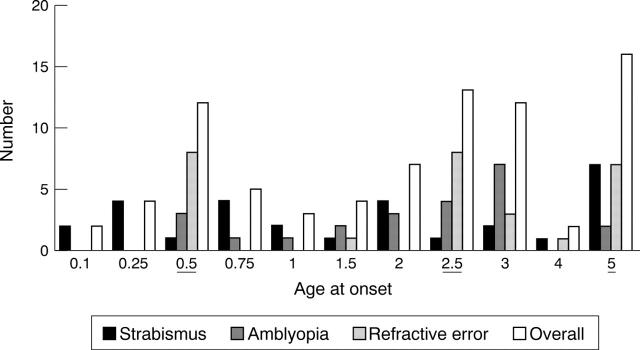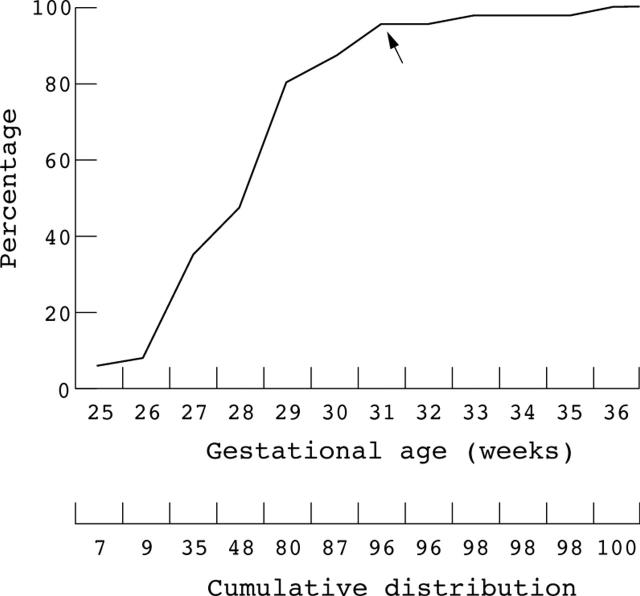Abstract
AIM—To establish recommendations for long term ophthalmological follow up of prematurely born infants. METHODS—130 infants with a gestational age (GA) <37 weeks and born between 1 November 1989 and 31 October 1990 were enrolled in a prospective study about the development of strabismus, amblyopia, and refractive errors. Infants were subdivided in three groups according to GA: A <28 weeks (n=32), B ⩾28-⩽32 weeks (n=64), C >32-<37 weeks (n=34). Ophthalmological assessment took place at the postconceptional age of 32 weeks, at term and at 3, 6, 12, and 30 months post term. At the age of 5 years parents received a questionnaire and a majority of the children was examined again (n=99). RESULTS—At the age of 5 years 46 infants were known to have strabismus (n=29) and/or amblyopia (n=22) and/or refractive errors (n=22). Statistical analysis showed that gestational age, duration of supplementary oxygen, and duration of hospitalisation were important predictive variables for the development of strabismus, amblyopia, or refractive errors (SAR) at the age of 5 years (p<0.05). Infants with a GA ⩽32 weeks had a significantly higher risk of developing SAR than infants with a GA >32 weeks, who developed an incidence comparable with the normal population. Strabismus developed mainly in the first year of life and at the age of 5 years. Most infants with amblyopia were detected at the age of 2-3 years. Refractive errors were found in the first year of life and at the age of 2.5 and 5 years. CONCLUSION—Infants with a GA <32 weeks should be selected for long term ophthalmological follow up. These infants should be screened at the age of 1 year, in the third year of life (preferably at 30 months), and just before school age (including testing of visual acuity with optotypes).
Full Text
The Full Text of this article is available as a PDF (135.4 KB).
Figure 1 .
Age at onset of strabismus, amblyopia, and refractive errors of infants who had been classified as having ophthalmological abnormalities at the age of 5 years. The ages at which follow up examinations were originally scheduled are underlined.
Figure 2 .
Cumulative distribution of infants with ocular abnormalities (strabismus, amblyopia, and/or refractive errors) at the age of 5 years, according to gestational age at birth. If only infants with a gestational age ⩽31 or ⩽ 32 weeks had been screened, 96% of infants with ophthalmological abnormalities would have been detected.
Selected References
These references are in PubMed. This may not be the complete list of references from this article.
- Darlow B. A., Clemett R. S., Horwood L. J., Mogridge N. Prospective study of New Zealand infants with birth weight less than 1500 g and screened for retinopathy of prematurity: visual outcome at age 7-8 years. Br J Ophthalmol. 1997 Nov;81(11):935–940. doi: 10.1136/bjo.81.11.935. [DOI] [PMC free article] [PubMed] [Google Scholar]
- Darlow B. A., Clemett R. S. Retinopathy of prematurity: screening and optimal use of the ophthalmologist's time. Aust N Z J Ophthalmol. 1990 Feb;18(1):41–46. doi: 10.1111/j.1442-9071.1990.tb00583.x. [DOI] [PubMed] [Google Scholar]
- Holmström G., el Azazi M., Kugelberg U. Ophthalmological follow up of preterm infants: a population based, prospective study of visual acuity and strabismus. Br J Ophthalmol. 1999 Feb;83(2):143–150. doi: 10.1136/bjo.83.2.143. [DOI] [PMC free article] [PubMed] [Google Scholar]
- Holmström M., el Azazi M., Kugelberg U. Ophthalmological long-term follow up of preterm infants: a population based, prospective study of the refraction and its development. Br J Ophthalmol. 1998 Nov;82(11):1265–1271. doi: 10.1136/bjo.82.11.1265. [DOI] [PMC free article] [PubMed] [Google Scholar]
- Palmer E. A., Flynn J. T., Hardy R. J., Phelps D. L., Phillips C. L., Schaffer D. B., Tung B. Incidence and early course of retinopathy of prematurity. The Cryotherapy for Retinopathy of Prematurity Cooperative Group. Ophthalmology. 1991 Nov;98(11):1628–1640. doi: 10.1016/s0161-6420(91)32074-8. [DOI] [PubMed] [Google Scholar]
- Pennefather P. M., Clarke M. P., Strong N. P., Cottrell D. G., Fritz S., Tin W. Ocular outcome in children born before 32 weeks gestation. Eye (Lond) 1995;9(Pt 6 SU):26–30. [PubMed] [Google Scholar]
- Pott J. W., Van Hof-van Duin J., Heersema D. J., Fetter W. P., Schreuder A. M., Verloove-Vanhorick S. P. Strabismus in very low birth weight and/or very preterm children: discrepancy between age of onset and start of treatment. Eur J Pediatr. 1995 Mar;154(3):225–229. doi: 10.1007/BF01954277. [DOI] [PubMed] [Google Scholar]
- Robinson R., O'Keefe M. Follow-up study on premature infants with and without retinopathy of prematurity. Br J Ophthalmol. 1993 Feb;77(2):91–94. doi: 10.1136/bjo.77.2.91. [DOI] [PMC free article] [PubMed] [Google Scholar]
- Schalij-Delfos N. E., Zijllmans B. L., Cats B. P. Towards a universal approach for screening of retinopathy of prematurity (ROP). Doc Ophthalmol. 1996;92(2):137–144. doi: 10.1007/BF02583285. [DOI] [PubMed] [Google Scholar]
- Schalij-Delfos N. E., Zijlmans B. L., Wittebol-Post D., Tan K. E., Cats B. P. Screening for retinopathy of prematurity: do former guidelines still apply? J Pediatr Ophthalmol Strabismus. 1996 Jan-Feb;33(1):35–38. doi: 10.3928/0191-3913-19960101-10. [DOI] [PubMed] [Google Scholar]
- de Vries L., Dubowitz L. M. Cystic leucomalacia in preterm infant: site of lesion in relation to prognosis. Lancet. 1985 Nov 9;2(8463):1075–1076. doi: 10.1016/s0140-6736(85)90951-1. [DOI] [PubMed] [Google Scholar]




